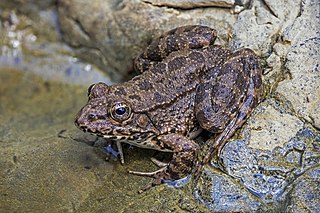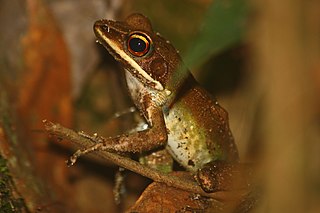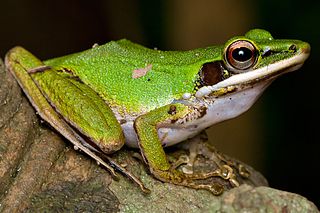
True frogs is the common name for the frog family Ranidae. They have the widest distribution of any frog family. They are abundant throughout most of the world, occurring on all continents except Antarctica. The true frogs are present in North America, northern South America, Europe, Africa, and Asia. The Asian range extends across the East Indies to New Guinea and a single species, the Australian wood frog, has spread into the far north of Australia.

The fungoid frog or Malabar Hills frog is a colourful frog found on the forest floor and lower vegetation in the Western Ghats in south-western India from Bombay to Kerala. It is very similar to another species with which it overlaps partly in range, Hydrophylax bahuvistara which extends further into parts of central India. Although restricted in range within peninsular India, they are of least conservation concern. Their upper parts vary in colour from brownish-red to bright crimson.

Amnirana is a genus of frogs in the family Ranidae, "true frogs". The genus is primarily found in Sub-Saharan Africa, but one species occurs in parts of southern and southeastern Asia. Some of the African species are widespread but contain undescribed cryptic diversity. Most species have a white upper lip, and the genus is sometimes known as the white-lipped frogs.

Meristogenys is a genus of true frogs from Borneo. Its tadpoles are adapted to fast-flowing mountain streams and easily recognizable by their divided upper lip with ribs on the outside.

Fejervarya limnocharis is a species of frog found in South East Asia and parts of Indochina. It is known under many common names, including Boie's wart frog, rice field frog, and Asian grass frog. Molecular studies of the species complex suggest that there may be multiple species involved.

Indosylvirana aurantiaca, commonly known as the golden frog, is a species of frog endemic to the Western Ghats of India. The species is also known as the Trivandrum frog, the common wood frog, or the small wood frog.

Humerana lateralis is a species of frog in the family Ranidae. It is found in Cambodia, Laos, Myanmar, Thailand, and Vietnam. It is commonly known as Kokarit frog, yellow frog or (ambiguously) wood frog.

Chalcorana labialis, also known as the white-lipped frog, is a species of "true frog" in the family Ranidae. As currently known, it is endemic to Peninsular Malaysia, although it might also occur in Singapore. Molecular data suggest presence of three distinct lineages in the same area, one of which is not closely related to Chalcorana labialis and which could represent an unnamed species.

Hylarana, commonly known as golden-backed frogs, is a genus of true frogs found in tropical Asia. It was formerly considered highly diverse, containing around 84 to 96 valid species, but taxonomic revision resulted in a major change in the contents of the genus, and today it is recognised as containing just four species.

Sylvirana is a genus of true frogs, family Ranidae, found in South and East Asia, from northeastern India in west to China in the north, Taiwan in the east, and Thailand in the south. Originally proposed as a subgenus of Rana in 1992, it has been considered both a full genus and a synonym of Hylarana. Its current recognition at generic level stems from molecular genetic analyses published in 2015.

Papurana is a genus of frogs in the family Ranidae, "true frogs". They are known from Southeast Asia, New Guinea, and northern Australia. Papurana daemeli is the only ranid frog found in Australia.
Chalcorana chalconota is a species of "true frog", family Ranidae. It is endemic to Indonesia and occurs in southern Sumatra, Java, Bali, and a few smaller islands. Populations previously assigned to this species now belong to a number of other Chalcorana species, leading to the current delineation of Chalcorana chalconota with a much narrower range. This species is also known as the Schlegel's frog, brown stream frog, copper-cheeked frog, or, among with many other species, white-lipped frog.

Chalcorana eschatia is a species of "true frog" in the family Ranidae. It is known from southern Thailand, but is likely to be more widespread. It was split off from Chalcorana chalconota by Robert Inger and colleagues in 2009, along with a number of other species in so-called "Rana chalconota group". The specific name eschatia, derived from the Greek word for "outskirt", refers to distribution of this species being at the edge of the geographical range of the group.

Sumaterana crassiovis is a species of true frog. It is endemic to Sumatra, Indonesia. It is also known as the Bander Baru frog, Korinchi frog, and Kerinci cascade frog.

Chalcorana megalonesa is a species of true frog in the family Ranidae, the "true frogs". It is endemic to Borneo and is known from both Malaysia and Indonesia (Kalimantan). It was split off from Rana chalconota in 2009 by Robert Inger and colleagues, along with a number of other species. Common name large white-lipped frog has been coined for it.
Chalcorana parvaccola is a species of "true frog" in the family Ranidae. It is endemic to Sumatra, Indonesia. It was split off from Chalcorana chalconota by Robert Inger and colleagues in 2009, along with a number of other species. The specific name parvaccola is derived from Latin parvus meaning small and accola meaning neighbor, and refers to this species being smaller than its "neighbor", the related Sumatran species Chalcorana rufipes.

Chalcorana raniceps, also known as the copper-cheeked frog, white-lipped frog, or Peters' Malaysian frog, is a species of "true frog" in the family Ranidae. It is endemic to Borneo, including Brunei Darussalam, Kalimantan (Indonesia), and Sarawak (Malaysia), although it is likely to occur more widely. Previously mixed with Chalcorana chalconota and believed to have much wider distribution, its range was delimited to Borneo in the revision of "Rana chalconota" complex by Robert Inger and colleagues in 2009.
Chalcorana rufipes is a species of "true frog" in the family Ranidae. It is endemic to Sumatra, Indonesia. It was split off from Chalcorana chalconota by Robert Inger and colleagues in 2009, along with a number of other species. The specific name rufipes is derived from Latin rufus meaning reddish and pes meaning foot, in reference to the reddish tinge on the underside of the pedal webbing in life.

Alcalus is a small genus of frogs in the family Ceratobatrachidae. It is the only member of the subfamily Alcalinae. Its sister taxon is Ceratobatrachinae. Common name Alcala's dwarf mountain frogs has been proposed for the genus. They are found in Palawan Island, Borneo, and the Malay Peninsula. They prefer semi-aquatic microhabitats.

Sumaterana, commonly known as Sumatran cascade frogs, is a genus of true frogs in the family Ranidae endemic to the island of Sumatra, Indonesia. Species inhabit fast-flowing streams found in primary or secondary forests.
















